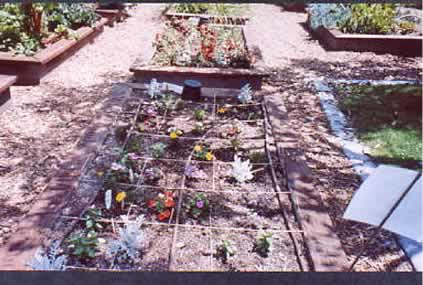|
Other Specialty Gardens
In addition to Bird and Butterfly Gardens, here are a few other suggestions:
Herb Garden
Herb gardens are very popular in schools. The beds are planted with an assortment of culinary and fragrant herbs. You may want to devote extra space to specialize in many varieties of one herb such as basil. Once established, herbs require very little maintenance other than watering and weeding. Almost all herbs grow in the San Diego area and most can be started with transplants, cuttings or seeds. Many seed companies have special assortments of herb seeds. Perennial herb plants will last for many years. A large container such as a half-barrel makes an ideal herb garden.
Pizza Garden
Most children love pizza! Why not have a small section of the garden for plants that are part of a pizza recipe: tomatoes, onions, garlic, oregano, basil and peppers. These warm season crops can be planted from mid-spring to early summer. Lay out a six-foot diameter, or larger, round bed and divide it into six or more pie shaped “slices”. Plant each “slice” with a different pizza ingredient. Use several different kinds of tomato and pepper plants to make more slices and add variety. Outline the borders of the “slices” with border plants such as alyssum or dwarf marigold.
Square Foot Garden
Lay out an area and divide it with string into one-foot square sections. Each individual student may plant a square with a different color of low growing plants such as begonia, dwarf marigold, flowering kale, primrose, portulaca, pansy, etc. A border of any low growing plant will finish the edges. Click here to go to School Garden References for a book on Square Foot Gardening.
 |
| Example of a Square Foot Garden in progress |
Succulent Garden
A succulent is any plant that stores water in its leaves, stems or roots to withstand drought conditions. Most succulents come from desert or semi-desert areas. This makes the San Diego area an ideal place to have a special garden for succulent plants. There are a great variety of succulents. Most are easy to grow and require very little attention once established. They may be planted in decorative containers and used as accent plants at various locations around the school. Students can easily propagate succulents from cuttings and sell them at plant sales as a means of raising funds to support the garden. Oddly shaped succulents often attract curious students. Be careful to research any possible harmful effects before planting just any succulent in your school garden.
| Caution - A cactus plant is a succulent. Because of their spines and “special handling” requirements, spiny cacti are not recommended for school gardens. |
Native Plant Garden
For centuries native plants have provided Native Americans with food, medicine, dyes, basketry, tools, construction materials, and materials for rituals. Therefore, a garden of native plants can be an excellent way to integrate it with history, art, creative writing, cuisine, conservation, and experimentation. Many native plants attract birds and butterflies and therefore, may provide areas for wildlife study on the school grounds.
The drought-tolerant character of the chaparral and coastal sage plants make them popular in school gardens. Once established, they do not require much care or irrigation. Because of their extensive root systems, they do better in landscape plantings where their roots can grow and develop naturally rather than in the confines of a raised bed. Some schools use selected varieties in landscaped beds around the school property and parking lot dividers. Once planted, each specific variety should have a permanent weather resistant marker for easy identification by students.
Members of the local California Native Plant Society may be willing to provide advice, planting instructions and assistance in the selection of varieties for the school’s native plant garden. A helpful reference is Southern California Native Plants for School Gardens by Betsey Landis. Click this link http://www.cnpssd.org to go to The California Native Plant Society for additional publications and information.
A garden with a specific focus can increase student interest in the school garden program. Imagination is the only limit to the numerous topics that can become the subject of a garden. Specialty gardens have included color wheels, a focus on one or more storybooks (e.g., Peter Rabbit), flag designs, geometric layouts, artistic designs, and gardens with plants from a specific continent or country.
|
